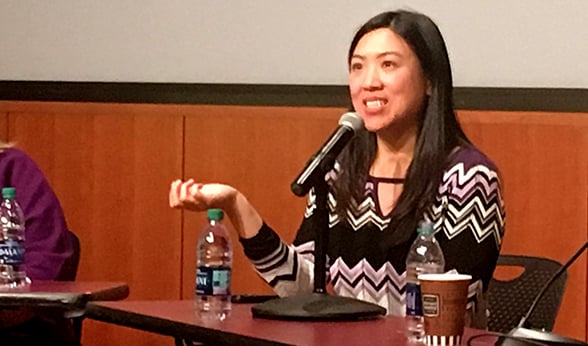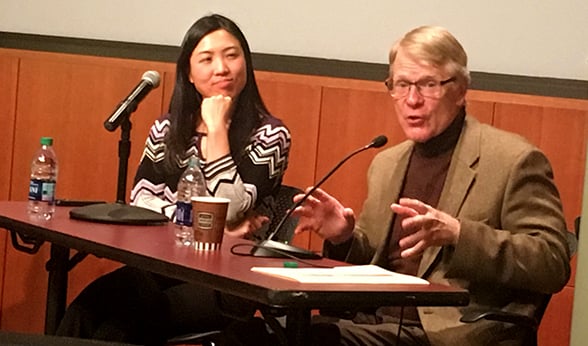From routine questions such as, "When is it time take the car keys away from an Alzheimer’s patient?" to queries about the progress of research into the mysterious disease, a panel of experts, including two from the University of Colorado Anschutz Medical Campus, led a discussion on the illness that affects 5.5 million people in the United States.
About 100 people braved a frigid and snowy evening to attend the Feb. 7 event (it sold out quickly online) at The Denver Post Auditorium. Over 2,000 people viewed the video stream online. The Post recently published a three-part series about a Greeley family grappling with multiple diagnoses of the Alzheimer’s, and the panel was part of the newspaper’s larger coverage.
Jonathan Woodcock, MD, associate professor of neurology and clinical director of the Memory Disorders Clinic and the Rocky Mountain Alzheimer’s Disease Center, and Hillary Lum, MD, PhD, assistant professor of medicine-geriatrics, both CU School of Medicine representatives, were joined on the panel by Amelia Schafer, executive director of the Alzheimer’s Association Colorado Chapter. Post reporter Jessica Seaman, who wrote the series, moderated the discussion.
Seaman asked a series of questions of the panel before opening the discussion to audience questions. Her first question: How does Alzheimer’s disease differ from normal aging?
Woodcock said the brain starts getting smaller around age 30, and while some cognitive degeneration occurs in normal aging, people generally can maintain, to varying degrees, independent function. But with Alzheimer’s disease, after the onset of clinical manifestations, cognitive changes are much more profound and, over time, the person loses the ability to function independently.
Schafer said the Alzheimer’s Association website has 10 warning signs that a person may have Alzheimer’s.
Diagnosing Alzheimer’s
Seaman asked why there is often a gap between the start of symptoms and a diagnosis of Alzheimer’s disease.
 Hillary Lum makes a point about caring for people with Alzheimer's disease during the Feb. 7 panel discussion.
Hillary Lum makes a point about caring for people with Alzheimer's disease during the Feb. 7 panel discussion.
From the perspective of a primary care physician, Lum said, it takes time to gather all the facts about behavioral changes both the patient and their loved ones are noticing.
“It can also take time doing various tests, perhaps stopping things that may also be hurting the brain, that might be causing memory changes or brain challenges,” she said. “Sometimes that can be a matter of weeks, months or even years to think through what is the right diagnosis. We know that it is a very weighty diagnosis, and emotionally challenging.”
Woodcock said one of the main reasons Alzheimer’s isn’t identified sooner is due to loved ones making accommodations and not noticing the severity of the situation. Still, it’s very important for a family member to provide his or her perspective on the loved one’s behavior when a person is examined for possible Alzheimer’s.
How can people reduce their risk?
What can people do to reduce the risks of getting the disease, Seaman asked.
The panelists said that while there is no known single cause of Alzheimer's disease, heredity plays a role. One active area of gene research is examining a gene called APOE (apolipoprotein E), which has a variant associated with Alzheimer's. People with the variant APOE-e4 have a higher risk of getting the disease, but it's not a guarantee. Adding to the puzzle, there are many cases where people do not have the APOE-e4 variant but still develop Alzheimer's.
Schafer said the Alzheimer’s Association is increasing study into how lifestyle factors might both contribute to the disease as well as slow down the progression.
 Jonathan Woodcock talks about how Alzheimer's disease affects the brain during the panel discussion at The Denver Post Auditorium.
Jonathan Woodcock talks about how Alzheimer's disease affects the brain during the panel discussion at The Denver Post Auditorium.
Woodcock added that evidence shows regular exercise, a healthy diet, social and cognitive activities, stress reduction and adequate sleep can all help reduce risks. “But we also know that people can follow all the rules and be really committed to a good, healthy lifestyle, and still if any of the neurodegenerative diseases happen, Alzheimer’s included, they can progress in spite of your very best efforts. … We still have a lot to learn.”
Asked what people should expect when a family member is diagnosed with Alzheimer’s, the panel said the disease’s progression can be very long and varies by the individual. Lum said it can be “very tricky” to know what to plan for the patient and family and when because “we don’t know how long this journey will be. My commitment, as a primary care physician, is that we will be there the entire time. I hope that you expect that of us.”
Take the car keys?
On the delicate subject of taking the car keys from an Alzheimer’s patient, the panelists said it comes down to a question of when. “In clinic, I’m amazed that I can tell a patient or family the diagnosis is Alzheimer’s and as they leave the office I get hugs,” said Woodcock, who added a bit of levity: “When I tell them they can’t drive anymore, I’m not sure I’ll get out alive.”
Other topics discussed included how to deal with an Alzheimer’s patient’s access to guns as well as whether marijuana offers positive effects for symptoms (a patient in the Post series said it offered some relief). The panelists advised great care in using marijuana, especially in how it reacts with medications. “I recommend knowing your dispensary well because dispensaries and preparations vary,” Lum said. “Also starting low and going slow.”
On the research front, Seaman asked: how is the fact that there’s no known cure for Alzheimer’s affecting researchers’ and physicians’ work in terms of finding a cure?
Woodcock said he views the research effort as not being just about Alzheimer’s, but about the brain and how the organ ages. “This is a disease that happens in the brain, and is very strongly correlated with aging, which is why we’re seeing more of it, because people are living longer,” he said. “We really need to understand how Alzheimer’s is affecting your brain and how all these different things like inflammation, diet and exercise are affecting aging as well as the development of Alzheimer’s disease.”
Importance of research
Most of the research has emphasized amyloid proteins associated with Alzheimer’s, he noted. Yet, more than 200 clinical trials of medications designed to impact amyloid plaque in the brain have not produced a cure.
“This has led to a lot of creativity in terms of other aspects of Alzheimer’s disease, which may be important parts of the puzzle and may lead to new treatments as well,” he said. “We may actually end up with a cocktail of medications that affect different aspects of the development of the pathology of Alzheimer’s disease.”
There is currently no single test that identifies Alzheimer’s. Woodcock said an effective blood test into Alzheimer’s pathology is likely a few years away. “Even when we get those tests, we won’t know what your particular function is on the basis of those tests, so this is still a complicated matter.”
The discussion ended with Woodcock emphasizing the importance of research: “Right now the United States spends between 80 and 160 times as much on the care of these cognitive and neurodegenerative diseases as we do on research. Talk to your legislators about supporting research.”
Photos by Helen Gray, Rocky Mountain Alzheimer's Disease Center




